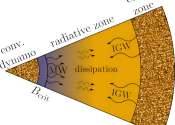Watch a star get destroyed by a supermassive black hole in the first simulation of its kind
Giant black holes in the centers of galaxies like our own Milky Way are known to occasionally munch on nearby stars.

Giant black holes in the centers of galaxies like our own Milky Way are known to occasionally munch on nearby stars.
Astronomy
Aug 24, 2024
0
37

Measuring the distance to truly remote objects like galaxies, quasars, and galaxy clusters is a crucial task in astrophysics, particularly when it comes to studying the early universe, but it's a difficult one to complete.
Astronomy
Jul 12, 2024
0
53

The size of the solar system is defined by the volume of space over which the sun's influence exceeds those of other nearby stars in the Milky Way galaxy. This influence derives from two fundamental forces of nature: gravity ...
Astronomy
Jul 12, 2024
0
57

An international team has pioneered a "motion-picture" method for measuring the precession rate of the Milky Way's disk warp. Using a sample of Cepheid variable stars of different ages, this method allows the precession direction ...
Astronomy
Jul 1, 2024
0
195

Michigan State University researchers have made groundbreaking discoveries about the supermassive black hole at the center of our Milky Way galaxy. These findings, based on data from NASA's NuSTAR X-ray telescope, were presented ...
Astronomy
Jun 11, 2024
0
51

Looking like a glittering cosmic geode, a trio of dazzling stars blaze from the hollowed-out cavity of a reflection nebula in this new image from NASA's Hubble Space Telescope. The triple-star system is made up of the variable ...
Astronomy
May 15, 2024
0
74

A new study led by researchers at Durham University has uncovered a novel mechanism that could solve a long-standing mystery about decaying planetary orbits around stars like our sun.
Planetary Sciences
Apr 29, 2024
0
348

When spectacular cosmic events such as galaxy collisions occur, it sets off a reaction to form new stars, and possibly new planets that otherwise would not have formed. The gravitational pull that forces the collisions between ...
Astronomy
Feb 9, 2024
32
3718

This new NASA Hubble Space Telescope image shows ESO 185-IG013, a luminous blue compact galaxy (BCG). BCGs are nearby galaxies that show an intense burst of star formation. They are unusually blue in visible light, which ...
Astronomy
Feb 6, 2024
0
7

Stephen Lesage's phone started vibrating just after halftime on Oct. 9, 2022, while he was watching a soccer game in Atlanta with a friend. When Lesage saw the incoming messages, the match no longer seemed important. There ...
Astronomy
Jan 24, 2024
0
22